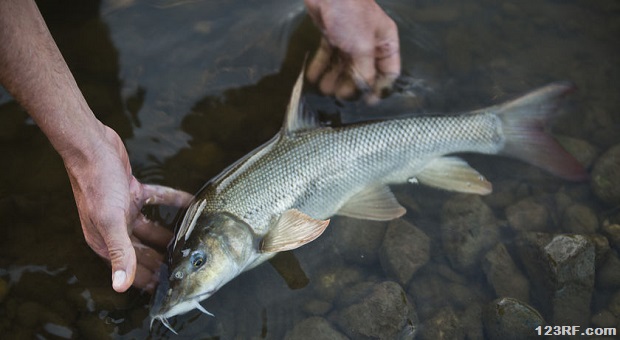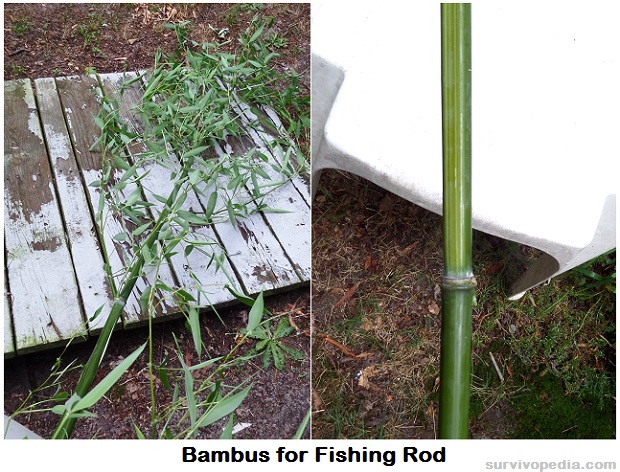Being able to fish could be a lifesaver after a crisis because you can easily stretch a limited stockpile of food to its greatest potential.
Here are some ways to fish if there are no modern fishing tackle and other equipment available for use.
Catching Fish Using Your Hands
Here is a simple method to catch fish if you see them swimming in shallow water:
- Silently and slowly enter the water. Gently and slowly move your hands under the fish with the palms up and the thumbs pointing upward.
- In a quick movement grab the fish. To keep the fish from wriggling away, the thumbs on each hand must be grabbing just behind the head and just behind the top fin. Your middle and ring fingers should go upward and curl so that the fish is locked into your hand.
- Bend the fish in half so that it curves toward you. In a fast lifting motion, toss the fish high up on the creek bank.
Note: If the creek water is deeper than 30 inches, you may want to chase the fish into a shallow eddy pool. Damming up the entrance of this pool should keep the fish from escaping and allow you to catch them when you want.
Making a Fishing Spear
Fishing spears are good for fishing, but like all fishing systems you need to practice to master the skill. Once you make a spear, be sure to practice with it to gain a feel for it.
- Find a good strong 6 foot long pole for the spear shaft.
- Use 6 to 8 small nails or small thin pieces of metal about 5 inches in length to make the spear head.
- Lash the nails or the metal scrap around the top of pole to hold it tightly in place, then sharpen the metal points.
Making a Fishing Rod
Fishing rods are used to get the bait further out into a river or a stream. It also helps to keep the fish from seeing you because of the distance.
- Cut a hard wood sapling or a bamboo about 8 feet long. It should have a good straight taper to it and be somewhat flexible. Cut off all small branches and leaves.
- Tie a cord to the tip of the rod, and while holding it, pull on the cord to test the flexibility. If the pole breaks try to find something more suitable.
- Once you find a suitable sapling, remove the test cord and tie the fishing cord to the pole at the top. Hold the pole straight up and let the fishing cord extend about 1 foot beyond the end of the pole.
- Put on a hook, bait, and go fishing.
How to Make Fishing Hooks
Making fishing hooks is not as difficult as most people think. They can be made from almost any material from steel safety pins, steel hair pins, old paper clips, thorns, small bones, and other materials found in nature.
Making Metal Fishing Hooks
Find old safety pins, hair pins, paper clips, or any other small metal wire that can be bent to make a fish hook without being easy pulled back straight. Bend a good anchoring point on one end of metal. Twist one metal wire around the other to make a loop, and bend the other side of the metal into a loop and sharpen the point. Cut a barb on the hook on the inside of the loop so the fish cannot get its lower lip free.
Making Hooks from Thorns, Small Bones, and Other Material Found in Nature.
Find thorns, bones, and other material that has a basic hook shape. How do you do this? Wrap and knot an anchor point. Rap and knot a sharp point on the other end of the hook made from thorns, bones or other materials. Add bait to hook and go fishing.
Using Fishing Rigs With Multiple Hooks
The main advantage to using fishing rigs with multiple hooks is that you can catch more fish in less time and you do not have to be physically there to fish. Bait the hooks and return every few hours to check the hooks and remove the fish.
Making a Bottom Fishing Rig
Step 1: Use a rock or other weight that will hold the fishing rig down on the bottom of the body of water you are fishing in.
Step 2: Tie a cord to the weight that is long enough to reach the bottom.
Step 3: Tie 2 or more hooks to this weight so that the baited hooks will be floating about a foot from the bottom in the water current.
Step 4: Anchor the fishing rig cord to a bush or small tree on the shore line.
Making a Midlevel Fishing Rig
- Repeat Steps 1 and 2 from above.
- Tie a wooden stick for a spreader about half way up the cord from the bottom.
- Tie 1 hook to each side of the spreader so the hooks can hang about 1-2 feet down.
- Anchor the fishing rig on shore to a bush or small tree.
Making surface and just below the water rigs.
- Use a 3 foot long log as a float.
- Attach the anchor cord to the middle of the log.
- Attach 4 hooks to 3 foot long lines.
- Attach each of the hook lines to the float log.
- Anchor the fishing rig on shore to a bush or small tree.
How to Build and Use a Simple Fish Trap and Holding Pen
- In a creek or small river, build a large wall of stones or wood in a “V” shape. With the tip of the “V” pointing downstream. Build the walls high so enough that the fish cannot jump over the walls and so that they must swim forward. At the tip of the “V” leave a small opening that leads into a holding area.
- Build a circle of rocks or wood high enough to keep the fish from jumping or swimming out of the holding area at the tip of the “V”.
- Keep gate stones near the opening to use for closing off the holding area.
To use this system you must first go up stream about 100 yards. Quietly enter the water and begin to splash the water in front of you with a stick heading down stream. This will panic the fish downstream into the “V” trap and into the holding pen. Close the holding gate door with rocks or wood. This secures the fish in the holding area for safe keeping.
Note: With this method it is possible to keep fish alive and fresh until needed.
Cleaning and Cooking Fish Off-grid
{adinserter emp}Shortly after catching a fish it is advisable to clean it since organs inside the fish decay quickly and can cause the fish to spoil. There are two basic ways to clean fish. The first way is filleting. The second way is to gut, remove the fins, and behead the fish.
Filleting a Fish
- First of all, be sure the fish is dead.
- Lay the fish on its side.
- With a sharp filleting knife (a long tapered bladed knife with a 12 inch blade), cut just behind the gill down to the spine. From here cut along the spine to the tail where the blade will exit the fish.
- Flip the fish over and repeat step 3.
- Thoroughly clean and wash the flesh.
Note: Save the fish head and spine to make fish soups or stews. If you do not want to eat it, save these parts and the organs for fish or animal baits.
Standard Way to Clean a Fish
Once again, be sure the fish is dead and lay it on its side. With a sharp knife cut the fish open from the anus to just behind the gills. Cut and scrape out all of the internal organs. Cut off all of the fins and the tail. Cut off the head. Clean and wash the fish.
Keep the fish head for making soups or stews and the organs for bait.
Cooking Your Fish
There are 4 ways to cook fish when living off the grid: planking, boiling, placing on hot rocks, and wrapped in grasses or leaves and placed on embers.
- Planking – Means cooking a fish steak or a fillet on a flat surface close to a fire. Find a flat board to put the fish on. Place fish on the board and secure the fish to the board by using pointed green twigs pushed through the fish into holes cut or drilled in the flat board. Place the plank next to fire with a thick stick to hold it up. When the first side is done, turn over the fish, reattach the fish to the plank, and cook until done.
- Boiling – Is the cooking of fish in a pot in boiling water. Fill a cooking pot about half full of water. Add fish to be cooked to the pot. Place the cooking pot over a cooking fire on a rack to cook. Boil until fish is done, and you know that the fish is done when it just starts to falls off the bones.
- Placing on Hot Rocks – Heat the rocks in a cooking fire. Be sure the rocks are dry and safe to heat. Many rocks can emit poisonous gasses or explode when heated. Once you determine rocks are safe to use with heating, keep them with you for cooking other foods in the future, or for producing steam. When the stones are hot enough, you will see heat waves coming off. Remove them from the fire and place them side by side to make an area to place the fish for cooking. Place the fish on the stones. Turn the fish over when the bottom side is done. Take the fish off the stones when the fish is completely done.
- Wrapping in Grasses or Leaves to Cook on Embers – Wrap the fish to be cooked in either fresh long grass or in fresh green leaves. Let a small cooking fire burn down to embers. Place the fish packets on the embers to cook. When the bottom side is done flip the cooking package over so the other side can cook. Remove from the fire when fish is completely done.
In a time of a major crisis, fishing is a way to restock or add to your food stockpile. If you do not have fishing equipment with you it is easy to make and use.
Practicing your fishing skills now can lead to enjoyable hobby as well as one that will sustain you in times of need.
This article has been written by Fred Tyrell for Survivopedia.










RAPTOR555 | June 25, 2014
|
They forgot fishing yoyos. I have 14 already rigged and ready to go in my emergency supplies and they take up only about 3/4 of a square foot. They work great and don’t have to be tended.
Frederick Tyrrell | June 25, 2014
|
Greetings RAPTOR555,
Frederick Tyrrell1 | June 25, 2014
|
Greetings RAPTOR555,
I also own and use Fishing YOYOs, however, this article was written for situations where people have no gear of any sort available. No matter whether gear gets old and worn out, lost, stolen, or left behind, these field methods can still be used for fishing.
Pingback:Prepper News Watch for June 26, 2014 | The Preparedness Podcast | June 26, 2014
|
Pingback:» How to Fish for Your Off-grid Survival | June 27, 2014
|
Pingback:Prepper News Watch for July 7, 2014 | The Preparedness Podcast | July 7, 2014
|
Pingback:Fish For Aquaponics System | Survival skills, survival guns, survival guide | January 7, 2015
|